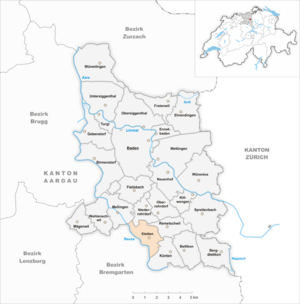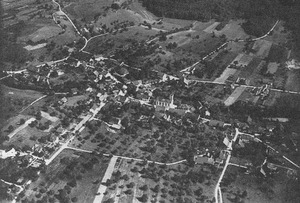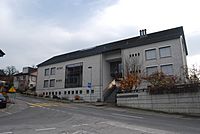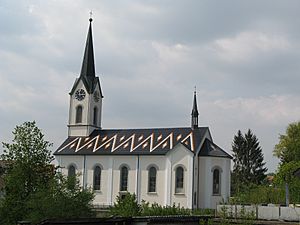Stetten, Aargau facts for kids
Quick facts for kids
Stetten
|
||
|---|---|---|
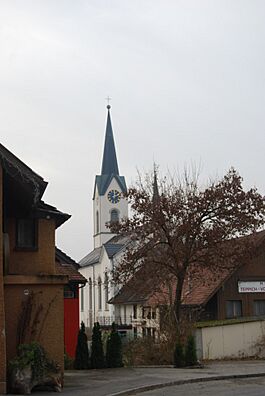 |
||
|
||
| Country | Switzerland | |
| Canton | Aargau | |
| District | Baden | |
| Area | ||
| • Total | 4.41 km2 (1.70 sq mi) | |
| Elevation | 383 m (1,257 ft) | |
| Population
(Dec 2020 )
|
||
| • Total | 2,224 | |
| • Density | 504.3/km2 (1,306.2/sq mi) | |
| Postal code |
5608
|
|
| Surrounded by | Künten, Mellingen, Niederrohrdorf, Niederwil, Remetschwil, Tägerig | |
Stetten is a small town, also called a municipality, in Switzerland. It is located in the Baden district. This district is part of the canton of Aargau. Stetten is a beautiful place in the country of Switzerland.
Contents
Geography of Stetten
Stetten covers an area of about 4.4 square kilometers. This is roughly 1.7 square miles. A large part of the land, about 50.2%, is used for farming. This means farmers grow crops or raise animals there.
Another big part, 27.7%, is covered by forests. These are areas with many trees. About 16.7% of the land has buildings or roads. This is where people live and move around. The rest of the land, 5.4%, includes rivers or lakes. These areas are not used for farming or building.
Stetten's Coat of Arms
The blazon (official description) of Stetten's coat of arms is quite special. It shows a red shield with a silver cross. This cross is called a "Cross Lorraine." It has two horizontal bars and a pointed bottom.
Above the cross, there are two silver five-pointed stars. These symbols tell a story about the town's history or values. Coats of arms are like special badges for towns.
People and Population
Stetten has a population of about 1,500 people. Around 18.8% of the people living in Stetten are from other countries. Over the past ten years, the number of people living in Stetten has slightly decreased.
Most people in Stetten speak German, about 90.1%. Albanian is the second most common language, spoken by 2.5% of the people. Italian is third, spoken by 1.9%.
In Stetten, many young people live there. About 10.6% of the population are children aged 0 to 9. Teenagers, aged 10 to 19, make up about 14.3% of the population. This shows Stetten is a place with many families.
In 2007, the most popular political party in Stetten was the SVP. They received 36.2% of the votes. This party focuses on Swiss traditions and independence. Other popular parties included the CVP, the FDP, and the SP.
Many adults in Stetten have a good education. About 78.2% of people aged 25 to 64 have finished high school. Many have also gone on to higher education. This includes university or a Fachhochschule (a type of professional university). In the 2008/2009 school year, 137 students attended primary school. Also, 51 students went to secondary school in Stetten.
Here's how Stetten's population has changed over time:
| Historical population | ||
|---|---|---|
| Year | Pop. | ±% |
| 1975 | 960 | — |
| 1980 | 972 | +1.2% |
| 1990 | 1,407 | +44.8% |
| 2000 | 1,587 | +12.8% |
Stetten's Economy
In 2007, Stetten had a low unemployment rate of 1.64%. This means most people who wanted to work had a job. The town's economy is divided into three main parts.
The first part is the primary economic sector. This includes jobs like farming and forestry. In 2005, 69 people worked in this sector. There were about 19 businesses related to farming.
The second part is the secondary sector. This involves manufacturing and construction. For example, people who build things or work in factories. In Stetten, 458 people worked in this sector. There were 31 businesses in this area.
The third part is the tertiary sector. This includes jobs that provide services. Examples are shops, offices, and schools. In Stetten, 215 people worked in this sector. There were 51 businesses offering services.
Many people who live in Stetten work outside the town. About 75.8% of residents travel to other places for their jobs. However, many people also come into Stetten for work. There were 645 jobs available in the municipality. About 11.8% of workers used public transport to get to work. Most people, 55.2%, used a private car.
Religion in Stetten
Based on the 2000 census, many people in Stetten are Christian. About 831 people, or 53.7%, are Roman Catholic. Another 395 people, or 25.5%, belong to the Swiss Reformed Church. There is also one person who belongs to the Christian Catholic faith.
See also
 In Spanish: Stetten (Argovia) para niños
In Spanish: Stetten (Argovia) para niños





